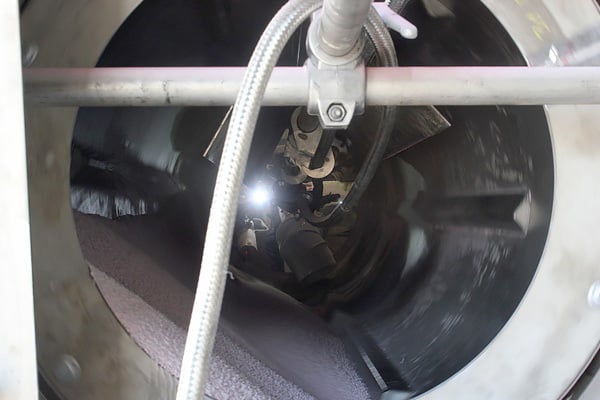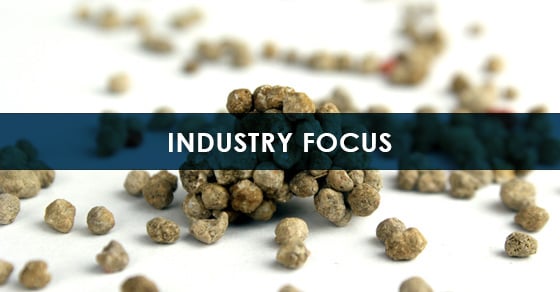Caking is one of the most challenging issues that granular fertilizer producers face. This ubiquitous problem causes an array of complications that threaten to degrade product quality, cause dust issues and safety hazards, and even spoil product, representing potentially significant losses and risk. One especially effective approach to reduce the potential for caking in granular fertilizers is through coating with anti-caking agents in a coating drum.
A well-applied coating not only provides an effective means of minimizing the potential for caking to occur, but it also creates a premium product that handles, stores, and applies as intended.
What Causes Caking in Fertilizers?
There are a number of reasons why a fertilizer product may experience caking. On a high level, caking can be attributed to the relationship between granule contact points. At these points of contact, capillary adhesion, crystal bridges, or surface diffusion can form bonds between particles – the beginnings of caked product. This is one reason why spherical granules are considered a more premium product over angular particles; with spherical granules, contact points between granules are minimized, reducing the potential for caking to occur.
The type of bond and potential for caking is dependent on a wide variety of factors, with environmental and storage conditions being the most influential. No matter what causes caking, however, the issues it can present are substantial, leading producers to invest heavily in a preventative approach.
Consequences of Caking
Fertilizer caking makes each subsequent step in the fertilizer lifecycle more difficult and less efficient. In handling and transportation, caked fertilizer is difficult to load and unload and often exhibits a difficult flowability, which can cause process flow issues, increase labor costs, and even clog equipment.
In storage facilities, caked fertilizer is a hazard to workers, causing dangerous and unexpected pile collapses. On application, caking can cause an uneven distribution of nutrients and may also present dust issues, representing a respiratory hazard to workers and creating a liability by risking the migration of fertilizer to surrounding areas.
Product that has become caked is often of lesser market value or may spoil completely, resulting in serious losses and added costs to the producer.
Additionally, the fertilizer market has come to expect an increasingly higher level of quality in their products. Producers that cannot meet the quality expectations of the market are not likely to survive.
How Coating Helps Prevent Fertilizer Caking
When it comes to caking, coating offers a valuable preventative method of reducing the potential for caking to occur through the uniform application of anti-caking agents.
Anti-caking agents are available in a variety of forms. As a coating, they take the form of either powders or liquids, with liquids being a more common medium. These materials may also be referred to as conditioners.
It’s important to note that because there are so many factors that can contribute to caking at any time during production, handling, and use, it’s important to recognize that coatings are not effective as a stand-alone solution; anti-caking agents should be used in combination with best practices in reducing the potential for caking during production, handling, storage, and application to truly prevent its occurrence.
For this reason, producing a quality granule upstream of the coating process is essential. A weak granular product, despite having been coated, may still result in caking, because of product breakdown; because dust will more readily dissolve in water, granules that degrade yielding dust have the potential to become caked.
Powder Coatings
Powder coatings serve as a barrier between particles to prevent caking and can also help control moisture absorption, as well as weaken any bonds that may form between particles. Typical powder coatings include diatomaceous earth, clay, and talc.
Powder coatings are not always ideal, as they can cause dust issues themselves. In some applications, the product may be coated with a powdered material, followed by a liquid coating to seal in the powder coating and prevent dust generation.
Liquid Coatings
Liquid coatings may serve a variety of functions to prevent caking. This might include the creation of a hydrophobic barrier on granules, a reduction in the capillary adhesion forces between particles, a modification of crystal growth, and more.
Common liquid anti-caking agents include oils, polymers, and specialty chemicals.
The Coating Process
Proper coating is critical in the effort to prevent caking. Since caking is most often caused by the formation of crystal bridges between contact points (typically a result of moisture and temperature), it is essential that each and every granule is completely and uniformly coated; any uncoated spots, no matter how small, invite the exchange of moisture between particles, and subsequently, the formation of crystal bridges and caking. Similarly, over-coated material can also present caking issues. For these reasons, the preferred device for coating when working with anti-caking agents is the coating drum.
How the Coating Drum Works
Coating drums are based on rotary drum technology. As material is fed into the rotating drum, a spray bar distributes the coating solution over the bed of material at a predetermined location(s) and feed rate. As a result of the tumbling action in the bed, (and sometimes the help of tumbling flights) the coating solution is evenly distributed among the granules in the bed. This tumbling action ensures a uniform coating on each and every granule and provides superior results over other coating methods.
The coating drum is also ideal when processing granules that could benefit from polishing or smoothing; the tumbling action of the rotating drum knocks off any loose edges and incorporates the resulting fines into the coating.

A FEECO Coating Drum equipped with ball and tube knockers for reducing buildup.
Oils, specialty chemicals, polymers, and more, are all materials frequently used as coatings in an effort to prevent caking. Coatings can also be formulated to serve other benefits as well, such as dust suppression or added nutritional value.
Coating drums can be provided as part of a new fertilizer production line, or integrated into an existing one.
Coating Process Development
Achieving a uniform and even coating on every single granule is a challenging task dependent upon a wide range of process and material parameters. This makes testing a critical element in developing a coating line that produces optimal results.
Testing programs such as those carried out in the FEECO Innovation Center work to assess the material, along with the coating, in terms of how to best design the coating drum and spray system to work with the unique parameters in order to produce the desired result. Some of the key variables explored during testing include:
- Surface characteristics of the material to be coated
- Coating temperature
- Coating application rate
- Material feed rate
- Spray method and location
- Nozzle type
- Drum fill percentage
- Retention time
- Drum speed

A coating process is tested in the FEECO Innovation Center
The FEECO Innovation Center tests coating on a scalable process to gather the process data necessary to design a commercial-scale unit. Coating formulation can also be evaluated.
Throughout the testing process, material samples can be produced for field trials.
Conclusion
Caking is a costly and hazardous issue that fertilizer producers face. Coating, when used in partnership with other best practices, offers producers a way to minimize the potential for caking, and subsequently, their exposure to the associated risks. The process of coating granular fertilizers with anti-caking agents must be thoroughly tested to produce a product that will truly minimize the potential for caking.
In business since 1951, FEECO is a veteran of the fertilizer industry. Our custom coating drums, granulation equipment, complete systems, scalable material testing, and parts and service support are relied upon every day by the industry’s largest players. For more information on our coating drums, or to discuss a testing program, contact us today!



